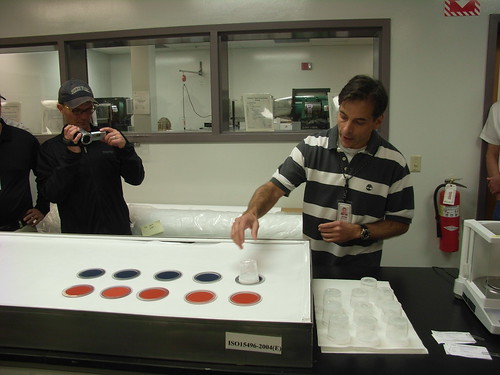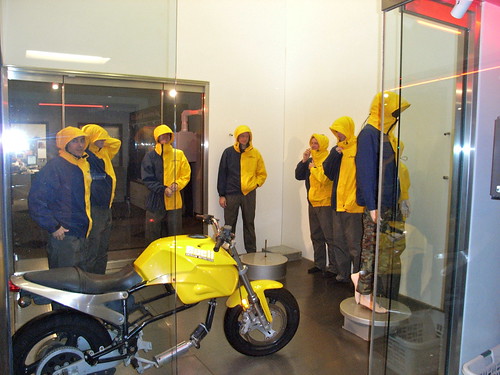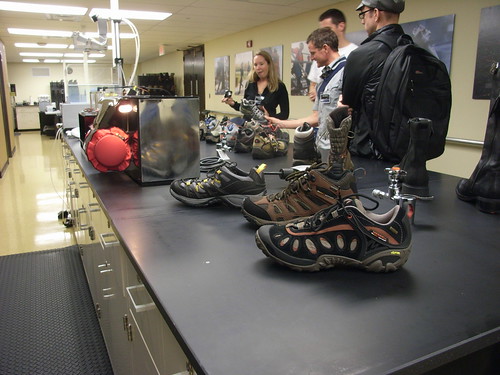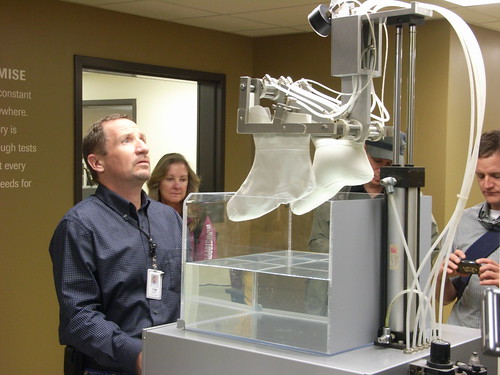The second day of the Blogger Summit started off nice ‘n’ early, with a behind the scenes tour of some of the Gore-Tex testing facilities in Maryland.
The first stop was a small conference room, where we were given a quick rundown of some of the properties of Gore-Tex products from Brad Hill and John Reaney. They went over some of the fundamentals of the brand, like what “breathability” actually means (it’s the ability to transfer moisture out – not the ability to vent air through), and how the Gore-Tex membrane works (it’s got microscopic holes that are large enough for evaporated sweat to pass through, but not big enough for liquid water to get in).
One great demonstration involved a pair of oversized gloves – one made of plastic and the other made of Gore-Tex. They had us all wear one on each hand, then move our fingers around for about 20 seconds. Even after that short amount of time, the plastic gloves felt clammy, while the Gore-Tex glove felt fine. Here’s Steve from the ski site TetonAT, making sure the Gore-Tex glove was waterproof and that his hands didn’t get moist:
They then gave us the rundown on the different types of Gore-Tex and Windstopper shells, which was mainly for the benefit for those in places that get weather. Here in SoCal, if you’re looking for Gore stuff, you can probably stick to the lighter, more collapse-able Gore-Tex Paclite Shells or Windstopper Active Shells during the cooler months, unless you’re headed somewhere that has actual weather.
After the crash course in Gore-Tex, we were shuffled through one of the factories to see what kinds of tests these products have to go through before they hit store shelves. The big one was something called the “Sweaty Hot Plate Test,” which we were not allowed to take pictures of … but it’s the only industry standard of breathability that associates results with actual levels of human comfort – and not everyone in the industry does them.
We also saw a slew of tests that measured a product’s ability to transfer water vapor, initial and long-term waterproofing, and general durability.
The durability tests were the most low-tech and yet, some of the most visually interesting – rows and rows of washing machines are rigged to run continuously with products inside them, to look for signs of delamination, leakage, and unacceptable wear.
Every garment goes through about 100 hours of this per week, and they’re all tested to failure. The average standard passing-grade for consumer products is 500 hours, although military grade stuff can pass 1000 hours of washing machine abuse.
Just beyond these machines were standard washer-dryer units, which tested the laundering wear and tear.
All Gore-Tex garments are designed to be cleaned in a regular ol’ washer and dryer. I know I’ve been wary of putting expensive outdoor clothes in the dryer before, but apparently hang drying is actually one of the worst things you can do to garments with Gore-Tex – the layer of “Durable Water Repellent” that’s on every exterior is actually restored and repaired by heat – so the next time you come home with a dirty jacket, don’t feel afraid to throw it in the dryer or use a warm iron (on polyester setting) on it – and don’t throw a dryer sheet in with it! Dryer cycles will restore that layer of water repellent between 10-15 times. After that, you can buy additional waterproofing liquids to restore the garment again. (We were also told that dirt and even cigarette smoke can, over time, degrade the repellent, but a simple wash will fix that up).
Then, it was on to the human-based tests!
The Comfort Chamber is a sealed-off room that mimics real life outdoor conditions, from -50 to 150 degrees Fahrenheit – along with wind gusts. College students earn a few bucks by donning Gore-Tex garments and running on a treadmill in this chamber. We, however, just stood in front of the fans at 15 degrees – which was quite brisk – and then put on some Burton Gore-Tex sweatshirts to see how we felt afterward – which was actually pretty good. Shayboarder, however, missed some of her Colorado weather and decided to linger in the chamber for a few extra minutes.
From there, we suited up and got ready for the Rain Room.
The yellow half of the jackets had the water repellent coating on it, while the blue side didn’t. We all entered into a large glass chamber and prepared to get pelted with rain from above.
We all stayed remarkably dry – although the side without the water repellent definitely didn’t stay as warm as the one with it.
After that, we were shuttled off to another factory, where we got a quick overview of some of the testing their boots and gloves go through.
The same standards apply here – every single boot is tested multiple ways, and if it fails any one it’s sent back to the manufacturer. First, the linings are inflated and tested for their waterproofing abilities.
Then, to make sure the liner is still waterproof inside the shoe, they fill the shoe with water and load it into a centrifuge. If any water ends up on the glass enclosure, the test is ended and the boots are inspected to see where the water’s getting through.
All footwear is also put through something called the “Flex Test,” where shoes are placed into water and bent by an artificial foot, the same way it would be flexed if you were actually walking in it. The mechanical feet are covered in sensors, which can tell exactly where water is getting into the shoe, if at all. Hiking boots are usually tested to 200 thousand flexes, while military boots get up to 500 thousand.
Sadly, the photos and video I had of this test were corrupted on my flash card, so I don’t have anything to show – but Shayboarder has some good pics up, if you’d like to check ’em out. I’m sure more will arrive throughout the week.
What was really interesting me, from a commercial standpoint, is how Gore deals with the companies that make the products with Gore-Tex and Windstopper in them. Gore can (and has) rejected companies who want to use cheaper materials, or who aren’t willing to alter the design of their product after it fails one of Gore’s tests. Gore is also unique in that their guarantee applies to the entire product – not just the parts that Gore is actually responsible for making.
Next up – a hearty Q&A session, where Gore candidly discussed their competitors, their environmental impact, and plans for the future.
Disclosure – all of my expenses were paid for by Gore through the duration of the Summit.
Tags: care, clothing, experience more blogger summit, gear, gore-tex, science





